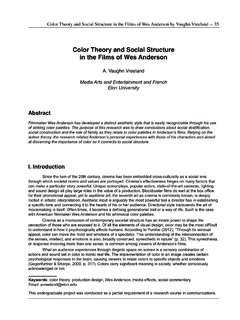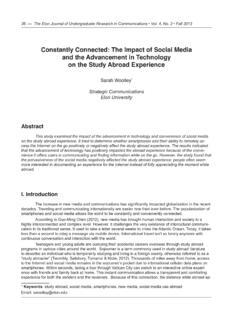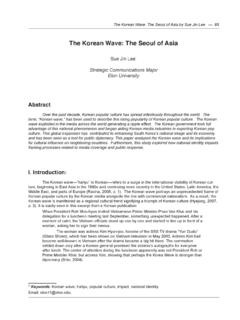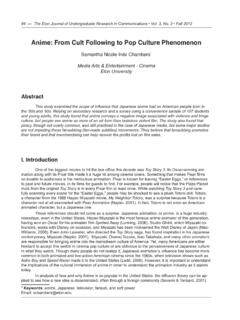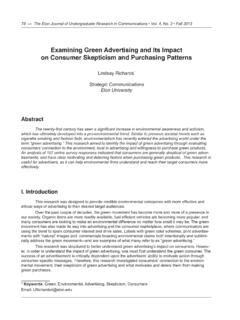Transcription of Representations of Women in Popular Film: A Study of ...
1 A Study of Gender Inequality in 2018 by Ian Kunsey 27 Keywords: Gender, film, representation , Women , equality Email: Representations of Women in Popular Film: A Study of Gender Inequality in 2018 Ian Kunsey Cinema and Television Arts Elon UniversitySubmitted in partial fulfillment of the requirements in an undergraduate senior capstone course in communicationsAbstractWhile much attention has been drawn to the lack of diversity in Hollywood, many minority groups still lack equal opportunities in the film industry. Roles for Women , in particular, have grown slowly, leaving developed female characters far below proportionality. This Study looks at the representation of Women in the top-five grossing live-action movies directed by men and the top-five grossing live-action movies directed by Women in 2018. Based on background quantitative data as well as a qualitative content analysis, this paper found that portrayals of Women are much more positive in movies directed by Women and that female directors frame female characters much more positively.
2 These positive portrayals are largely affected by the presence of a critical actor behind the IntroductionEven in the rapidly changing media landscape of the 21st century, movies have remained an integral part of American Popular culture. While methods of consumption have changed, millions of Americans still flock to theaters every year to see stories played out on the silver screen, with the domestic box office grossing $ billion in 2018 (Statista, ). Concurrently, the Academy Awards, the world s most prestigious cinematic awards, draws millions of viewers each year. The sustained prevalence of film in Popular culture positions the medium as a key cog in American society and Popular culture (Simonton, 2004).Yet, even in the year 2019, many Americans are not proportionally represented in film. These inadequacies in cinematic representation both on screen and off screen have prompted a number of social movements over the past few years, including the #OscarsSoWhite campaign.
3 The movement, which centered on the lack of racial diversity among Oscars nominees, resulted in the Academy of Motion Picture Arts and Sciences vowing to double the number of Women and people of color in the Academy s membership by 2020 (Reign, ). The #MeToo and Time s Up movements shifted the focus to promoting awareness and advocacy for sexual assault victims especially Women . Yet even with these social outcries, the Academy of Motion Picture Arts and Sciences and the film industry as a whole still do not adequately represent Women on and off screen. Stereotypic portrayals and the lack of complex female roles remain common in Hollywood and the media as a whole (Milburn, Mather, & Conrad, 2000). 28 Elon Journal of Undergraduate Research in Communications, Vol. 10, No. 2 Fall 2019 These negative depictions have implications that reach far beyond the entertainment industry.
4 Because the role of film in Popular culture and society, motion pictures largely reflect prevailing cultural attitudes about gender roles, norms, attitudes and expectations (Simonton, 2004, 781). In the same vein, depictions of minority groups in film and the media can be influential in the dissemination of stereotypes (Bazzini, McIntosh, Smith, Cook, & Harris, 1997). This dual cause-and-effect often results in a vicious cycle as societal stereotypes influence primarily male filmmakers who in turn create art that adds to said stereotypes (Simonton, 2004). While this is not the end-all-be-all of misrepresentation in media, this cycle is important to consider when evaluating portrayals of minorities in film. Although Representations of Women in film have improved in recent years, this growth has been mitigated by the fact that there has only been a 3% increase in female employment in the 250 top-grossing films since 1998 (Lauzen, 2018b).
5 The lack of significant progress is arguably most evident in the Academy Awards nominees and winners, with just one woman awarded Best Director in the 91-year history of the awards. In 2019, in the midst of social change and the #MeToo movement, zero female directors were nominated for Best Director and zero female directors were nominated for Best Picture. Additionally, each of the top 30 grossing movies in the in 2018 were directed by men (Box Office Mojo, ). Through this research paper, the top-five grossing live-action movies directed by men and the top-five grossing live-action movies directed by Women in 2018 were analyzed to better understand how Women are depicted in Popular film and how behind-the-scenes Representations affect these Literature ReviewThis literature review focuses on the current representation of Women in Hollywood, critical mass theory and critical actor theory, as well as a discussion of male and female stories, all of which seek to analyze how Women s roles in the film industry affect their representation on representation in the Film IndustryA vast pool of prior research, empirical and otherwise, proves the existence of sexual discrimination in Hollywood.
6 The term actress itself is laden with subtle sexism, as the suffix -ess implies that the roles of actor an actress differ as performed by men and Women (Simonton, 2004). While not intentionally malicious, this small difference points to inherent discrimination in the film industry. Discrimination theory bases itself upon the idea that members of a certain group are preferred, even when the work of these group members is indistinguishable from that belonging to another group (Lauzen, 2012b, 311). By differentiating, and seemingly preferring, male actors from female actors, the film industry shows its discriminatory tendencies. By employing these tendencies, the film industry discourages Women from entering the field and thus influences decisions to hire male workers instead of female workers (Lauzen, 2012b). This has led inevitably to a situation in which the are most often written, directed, and produced by men (Orwin, 2002, 271).
7 This is evident by the vast amount of quantitative research conducted on employment in the film industry. In 2018, Women accounted for only eight percent of directors at the helm of the top-250 grossing films in the United States, down one percent from 1998 (Lauzen, 2018b). Additionally, one in four films employed either zero Women or one woman in the roles of director, writer, producer, executive producer, editor, and cinematographer. Only one percent of films employed ten or more Women in those roles, compared to 74 percent of films employing ten or more men (Lauzen, 2018b). In addition to this lack of proportionality, the cultural devaluation of Women is reinforced by the fact that they do not receive star billing as often as men (Lincoln & Allen, 2004). According to Lauzen s It s a Man s (Celluloid) World report, only 36 percent of all major characters in 2018 s top-100 grossing movies were Women (Lauzen, 2018a).
8 While that number is up nine percent from 2002, female stars appear in far fewer films than their male counterparts and thus infrequently become movie stars (Lincoln & Allen, 2004). In this way, films inherently tell audiences that men are more important, in all kinds of contexts, than Women (Lincoln & Allen, 2004).These issues have a clear solution: give female filmmakers more, and equal, opportunities. When Women are hired as directors and writers, more female characters are employed (Sutherland & Feltey, 2017). In films with at least one female director and/or writer, Women comprised 43 percent of all speaking characters, A Study of Gender Inequality in 2018 by Ian Kunsey 29a number much more proportionate to the population than the 32 percent of female speaking characters present in films with exclusively male directors and writers (Lauzen, 2018a). This disparity shows the effect that employing female filmmakers has on gender representation .
9 However, female filmmakers tend to face far more unjust criticism than men when they are given positions (Kennedy, 2010).One of the most prominent of these criticisms is the idea that female filmmakers present more of a financial risk than male filmmakers. When faced with large budgets, studio executives tend to fall back on directors who have had box-office hits in the past (Lauzen, 2012b). These directors are often male. This presents a bit of a paradox in which Women are not hired for positions that require them to have previous jobs to prove their worth. In reality, films that employ at least one female director, executive producer, producer, and/or writer garner approximately the same domestic box office sales as do films with exclusively male representation in those roles (Lauzen, 2008). Despite this, Women are rarely afforded the same resources and budgets as men. This can partially be attributed to the emergence of the superhero genre generally the highest-grossing movies in modern day Hollywood.
10 Since the mid-2000s, when these films became widely Popular , the genre has been dominated by male directors. Until 2017 s Wonder Woman, directed by Patty Jenkins, no woman had directed a movie released by Marvel or DC, the two preeminent comic book studios in the film industry. While this trend seems to be changing with the upcoming releases of Cathy Yan s Birds of Prey, Patty Jenkins sequel to Wonder Woman, Cate Shortland s Black Widow, and Chlo Zhao s The Eternals, the lucrative, high-budget genre has largely benefited men, leaving Women to contend with small budgets and less box office 2018, these super hero movies and other action films accounted for 34 percent of the year s box office gross (The Numbers, 2018). Additionally, all nine superhero movies released in 2018 were directed by men. This disparity present in the superhero genre alone can partially explain why films directed by Women do not have budgets as large as movies directed by their male counterparts.
